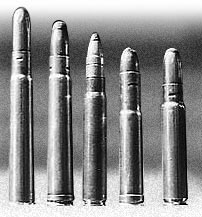|
 |
| L - R: .375 H&H Flanged Magnum; .375 H&H Belted Magnum; 9,3 x 62 Mauser; .400/.375 H&H Belted NE; 9,5 M - S. |
|
The .375 magnum is an out-growth of the intense rivalry between European and British gun makers to develop new standard cartridges in the early 1900’s. The military cartridges had been standardised around the world by 1893 (except in the USA) but in the sporting field there was considerable jockeying for position. 9,5 Mannlicher-Schoenauer, started the race for a large medium bore, suitable for general African and Asian hunting. The Mannlicher rifles are delightful little carbines and the calibre quickly took off. The British gun trade adopted the 9,5 M-S as the .375 Rimless NE (2 ¼), but Messrs Holland & Holland introduced their own round, the .400/375 Belted NE to compete. This cartridge was unique in that it was the first to use a belt for headspacing rather than a rim or using the shoulder. Ballistics for the .400/375 were identical to the 9,5. viz a 270 grain bullet at 2150 fps. The belted design certainly eased manufacturing procedure since it was nearly as easy to produce the correct headspace with a belt as with a rim, and yet didn’t give the feeding trouble/complicated magazine design of a rimmed case. Ease of headspacing is overlooked today, but in the early 1900’s precision machining had to be done by hand, and chamber reamers were soft and wore out quickly. Rimmed or belted cases were much simpler. In addition the chamber of a rimmed or belted case could be made oversize, which was a considerable aid to extraction from a hot or dirty rifle. Reloading was out of vogue in the British world and reliability of function was the key, even above accuracy.
At the same time as Holland & Holland were introducing their 400/375 (1905), Mr Bock of Berlin was introducing his incomparable 9,3. Adopted by Mauser in the same year, it soon eclipsed the 9,5 and became Africa’s standard large medium bore. The .400/375 almost died at birth. It offered nothing over the 9,5, except that the rifles were considerably more reliable (the early Mannlichers were quite temperamental), but cost several times as much. The 9,3 clearly outclassed both. It launched a bullet of better sectional density (.305 vs .274) some one hundred feet per second faster (in pre-1918 loadings, after which the ballistics of the 9,3 were further upgraded in Euopean loadings). These minor improvements in sectional density and velocity made all the difference. Neither the 9,5 M-S nor the .400/375 had sufficient penetration for frontal brain shots on elephant, and were decidedly marginal on shoulder shots on rhino or buffalo. The 9,3 possessed more than adequate penetration on all three species, and was the first cartridge that could be considered an all rounder.
In 1906 though, the first cartridge of the new ‘high velocity’ craze hit the market. The .280 Ross was adopted by the Canadian Army, and even with the limited powders then available, launched a 140 grain bullet at 2900+fps. This represented the sort of quantum leap in velocity that the early smokeless loads had over black powder. High velocity ‘Magnum’ cartridges and loadings became the rage, with non-magnum cartridges being rather passé. A cartridge had to deliver over 2500fps to be classified as a ‘Magnum’ (although manufacturers were rather loose with the term), and all the major English gun makers brought out at least one ‘Magnum’ cartridge. Even the British Army adopted one of the new 7mm Magnum cartridges for its new P13 service rifle, the 276 Enfield, but the first world war put paid to that. |